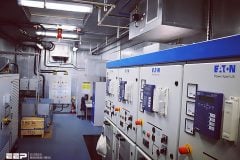Simple Spot Network Systems
The AC secondary network system is the system that has been used for many years to distribute electric power in the high-density, downtown areas of cities, usually in the form of utility grids. Modifications of this type of system make it applicable to serve loads within buildings.

The major advantage of the secondary network system is continuity of service. No single fault anywhere on the primary system will interrupt service to any of the system’s loads.
Most faults will be cleared without interrupting service to any load.
Another outstanding advantage that the network system offers is its flexibility to meet changing and growing load conditions at minimum cost and minimum interruption in service to other loads on the network.
Three major differences between the network system and the simple radial system account for the outstanding advantages of the network.
First, a network protector is connected in the secondary leads of each network transformer in place of, or in addition to, the secondary main breaker, as shown in Figure 2.
Also, the secondaries of each transformer in a given location (spot) are connected together by a switchgear or ring bus from which the loads are served over short radial feeder circuits. Finally, the primary supply has sufficient capacity to carry the entire building load without overloading when any one primary feeder is out of service.
A network protector is a specially designed heavy-duty air power breaker, spring close with electrical motor-charged mechanism, with a network relay to control the status of the protector (tripped or closed).


The network relay is usually a solid-state microprocessor-based component integrated into the protector enclosure that functions to automatically close the protector only when the voltage conditions are such that its associated transformer will supply power to the secondary network loads.
It also serves to automatically open the protector when power flows from the secondary to the network transformer.
The purpose of the network protector is to protect the integrity of the network bus voltage and the loads served from it against transformer and primary feeder faults by quickly disconnecting the defective feeder-transformer pair from the network when backfeed occurs.
The simple spot network system resembles the secondary-selective radial system in that each load area is supplied over two or more primary feeders through two or more transformers.
In network systems, the transformers are connected through network protectors to a common bus, as shown in Figure 2, from which loads are served.
The paralleled transformers supplying each load bus will normally carry equal load currents, whereas equal loading of the two separate transformers supplying a substation in the secondary-selective radial system is difficult to obtain.


The interrupting duty imposed on the outgoing feeder breakers in the network will be greater with the spot network system.
In spite of the spare capacity usually supplied in network systems, savings in primary switchgear and secondary switchgear costs often result when compared to a radial system design with similar spare capacity.
This occurs in many radial systems because more and smaller feeders are often used in order to minimize the extent of any outage when a primary fault event occurs.
In spot networks, when a fault occurs on a primary feeder or in a transformer, the fault is isolated from the system through the automatic tripping of the primary feeder circuit breaker and all of the network protectors associated with that feeder circuit.
This operation does not interrupt service to any loads.
After the necessary repairs have been made, the system can be restored to normal operating conditions by closing the primary feeder breaker. All network protectors associated with that feeder will close automatically.
The use of spot network systems provides users with several important advantages.
First, they save transformer capacity. Spot networks permit equal loading of transformers under all conditions. Also, networks yield lower system losses and greatly improve voltage conditions.
The voltage regulation on a network system is such that both lights and power can be fed from the same load bus. Much larger motors can be started across-the-line than on a simple radial system.
This can result in simplified motor control and permits the use of relatively large low voltage motors with their less expensive control.
Finally, network systems provide a greater degree of flexibility in adding future loads. They can be connected to the closest spot network bus.
They are commonly used in hospitals, high rise office buildings, institutional buildings or laboratories where a high degree of service reliability is required from the utility sources.
Spot network systems are especially economical where three or more primary feeders are available. Principally, this is due to supplying each load bus through three or more transformers and the reduction in spare cable and transformer capacity required. They are also economical when compared to two transformer double-ended substations with normally opened tie breakers.
Emergency power should be connected to network loads downstream from the network, or upstream at primary voltage, not at the network bus itself.
Bus configuration for a 3-unit commercial spot network
Figure 3 shows the bus configuration for a three-unit commercial spot network. Again, the ground return neutral bus is required which has only one point of connection to the grounding conductor.


Selective tripping is achieved in the same fashion as the double-ended network substation with ground fault relay for tie breaker (GFR-T) sensing ground current and operating the 86T device which then opens both Tie breakers. The ground relays GFR-1, GFR-2 and GFR-3 will only sense ground current after the Tie 86 lockout is energized and the tie breakers are open.
Interlocking auxiliary contacts on the 86-T with the GFR circuits guarantees this selective tripping and ensures the user that ground currents are accurately
measured.
The ampacity of the ground return neutral bus must meet the minimum requirements of the neutral bus.
It is prudent to size the ground return neutral bus the same size as the phase bus, because the ground and neutral carry fault currents during abnormal events.
The ampacity of the phase and neutral buswork must meet the gross demand plus spare capacity for growth as stipulated by the National Electrical Code (NEC) for the loads served.
If each transformer on a two-unit spot network has been sized with 100% redundancy, then each protector and load buswork should be rated to carry the entire load from one primary feeder and one transformer.
Three-unit spot networks can reduce the redundancy to 50% for the same loads because two units remain in service. Four-unit spot networks may reduce the redundancy to 33%, unless the loads need to be served from two remaining services in which case 100% redundancy is still required.
Sources:
- Power distribution systems by Eaton
- Spot Network Equipment by Eaton











Please guide me about how to calculate size of earthing strip in system. Fault level of HT and LT Panels.